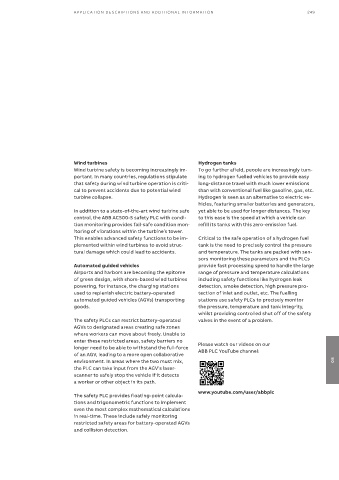Page 251 - PLC Automation
P. 251
APPLIC ATION DESCRIPTIONS AND ADDITIONAL INFORMATION 249
Wind turbines Hydrogen tanks
Wind turbine safety is becoming increasingly im- To go further afield, people are increasingly turn-
portant. In many countries, regulations stipulate ing to hydrogen fuelled vehicles to provide easy
that safety during wind turbine operation is criti- long-distance travel with much lower emissions
cal to prevent accidents due to potential wind than with conventional fuel like gasoline, gas, etc.
turbine collapse. Hydrogen is seen as an alternative to electric ve-
hicles, featuring smaller batteries and generators,
In addition to a state-of-the-art wind turbine safe yet able to be used for longer distances. The key
control, the ABB AC500-S safety PLC with condi- to this ease is the speed at which a vehicle can
tion monitoring provides fail-safe condition mon- refill its tanks with this zero-emission fuel.
itoring of vibrations within the turbine’s tower.
This enables advanced safety functions to be im- Critical to the safe operation of a hydrogen fuel
plemented within wind turbines to avoid struc- tank is the need to precisely control the pressure
tural damage which could lead to accidents. and temperature. The tanks are packed with sen-
sors monitoring these parameters and the PLCs
Automated guided vehicles provide fast processing speed to handle the large
Airports and harbors are becoming the epitome range of pressure and temperature calculations
of green design, with shore-based wind turbines including safety functions like hydrogen leak
powering, for instance, the charging stations detection, smoke detection, high pressure pro-
used to replenish electric battery-operated tection of inlet and outlet, etc. The fuelling
automated guided vehicles (AGVs) transporting stations use safety PLCs to precisely monitor
goods. the pressure, temperature and tank integrity,
whilst providing controlled shut off of the safety
The safety PLCs can restrict battery-operated valves in the event of a problem.
AGVs to designated areas creating safe zones
where workers can move about freely. Unable to
enter these restricted areas, safety barriers no Please watch our videos on our
longer need to be able to withstand the full-force ABB PLC YouTube channel:
of an AGV, leading to a more open collaborative
environment. In areas where the two must mix, 08
the PLC can take input from the AGV’s laser-
scanner to safely stop the vehicle if it detects
a worker or other object in its path.
www.youtube.com/user/abbplc
The safety PLC provides floating-point calcula-
tions and trigonometric functions to implement
even the most complex mathematical calculations
in real-time. These include safely monitoring
restricted safety areas for battery-operated AGVs
and collision detection.

